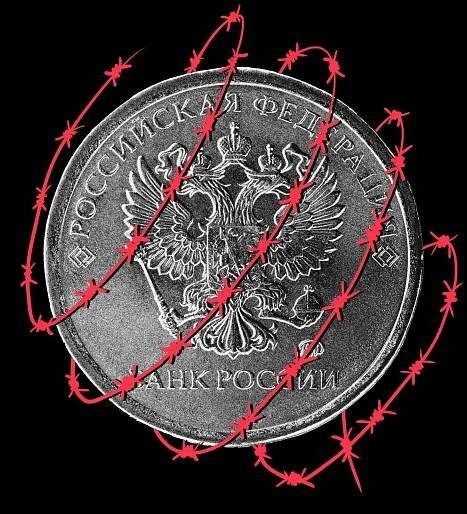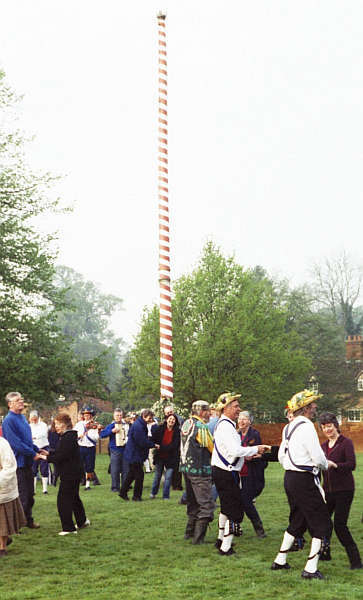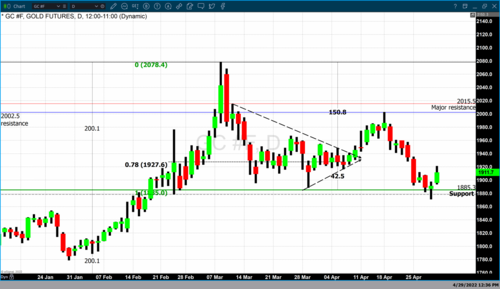What's in store for gold price as Fed remains laser-focused on inflation and its supersized hikes?
The gold market will be wrapped up in the Federal Reserve's interest rate decision next week as analysts see the U.S. central bank ignoring the steep drop in the U.S. Q1 GDP data and remaining fixated on fighting inflation.
Gold is looking to end April down 1.7% on the month despite Friday's gains. June Comex gold futures were last trading at $1,912.20, up $21 on the day.
"April was a terrible month for gold. Many traders were surprised by another strong move higher in the U.S. dollar. Greenback's strength was driven by safe-haven flows on concerns about economic slowdown across Europe, China's zero-COVID strategy, and expectations of a rather wide interest rate differential between the dollar and its major trading partners due to the Fed's aggressive stance," OANDA senior market analyst Edward Moya told Kitco News.
The Federal Reserve, scheduled to make its interest rate decision on Wednesday, has locked itself into an aggressive rate hike cycle for the next three meetings. "The market has around 250 basis points worth of rate hikes priced in over the next 12 months," Moya said.
The big surprise this week was the U.S. economy contracting 1.4% in the first quarter. But the Fed is likely to look past that negative number because the outlook for the second quarter looks better, according to analysts.
"You have to take a look at why the economy contracted. The consumer was still strong, and the consumption was still fairly robust. But imports were one of the key reasons why. They over-delivered when you consider that exports were soft. A lot of traders shrugged the data off a bit. Nothing to change Fed rate hike expectations," Moya explained.
Fed Chair Jerome Powell will remain focused on inflation, which is tricky to control, especially considering the type of price pressures the U.S. is seeing, noted CIBC World Markets chief economist Avery Shenfeld."Some are pointing to the fact that the Fed has never achieved as sharp a deceleration in inflation as it aims to engender without causing a recession," Shenfeld said. "That's actually not our central worry because we haven't really faced this type of inflation in the past … The problem is that just as this year's spikes in such prices have made the inflation problem look worse, next year's retreats will have the CPI understating the true trend. Getting inflation down will be easier than keeping it that way unless we slow the pace of hiring and prevent a further tightening in the labor market."
Here's what to expect from the Fed
The two main things the markets are anticipating to see next week are the 50-basis-point rate hike and the start of quantitive tightening.
"We doubt that the unexpected 1.4% annualized decline in first-quarter GDP will stop the Fed from hiking its policy rate by a bigger 50bp next week or from launching quantitative tightening. The Fed will stress the ongoing strength of employment growth, the temporary impact of the Omicron wave, and the pick-up in the growth rate of final sales to private domestic purchasers, which is arguably a better gauge of underlying demand. But the bottom line is that with inflation rampant, it simply doesn't have a choice; policy needs to be tightened rapidly regardless of the costs to the real economy," said Capital Economics chief North American economist Paul Ashworth.
The minutes from the last FOMC meeting suggested that "participants generally agreed that monthly caps of about $60 billion for Treasury securities and about $35 billion for agency MBS would likely be appropriate."
Strategists at ING said they are forecasting for the Fed to start with $50 billion "being allowed to run off each month before getting up to $95bn by September."
Looking forward, however, the Fed is unlikely to get more aggressive and talk about 75-basis-point rate hikes, said ING's chief international economist James Knightley, citing the weak GDP number. "For now, our base case remains that the Fed will follow up next week's 50bp hike with 50bp increases in June and July before switching to 25bp as quantitative tightening gets up to speed. We see the Fed funds rate peaking at 3% in early 2023," Knightley clarified.
 Gold is an 'ideal' asset right now but why isn't the price higher? Fidelity weighs in
Gold is an 'ideal' asset right now but why isn't the price higher? Fidelity weighs in
What gold price is looking for from the Fed
The gold market is looking at the Fed to show signs of optimism, said Moya. "Is inflation peaking? You are probably going to see many traders very fixated on that," he said.
The latest core PCE price index data published on Friday suggested that core inflation peaked at 5.2% annually in March, following 5.3% reported in February, Moya noted. "This is pretty significant. It is the first time we've seen a decline since October 2020. This could help the argument that Fed could develop a soft landing and not be as aggressive once we get past super seized rate hikes," he said.
After the Fed meeting, gold could start to benefit from some safe-haven flows, especially if uncertainty in the equity markets continues, Moya added.
The $1,875 an ounce level remains good support for gold in the short term. On the upside, Moya is watching $1,940 an ounce. "If we break $1,875 on the downside, gold could fall to $1,830. But this is the level at which many technical traders become bullish. That is when you see gold testing a 200-day moving average," he said.
It is only a matter of time before gold can break above its critical psychological $2,000 an ounce level, said Bloomberg Intelligence senior commodity strategist Mike McGlone. And the main trigger is likely to be the Fed showing some hesitancy in the face of the promised aggressive rate hikes.
"The base now appears closer to $1,800, and $2,000 is key resistance. We expect that it's just a matter of time for gold to potentially break above this threshold. A top potential catalyst is a trough in Fed's rate-hike expectations, which may not occur until the stock market declines further. The S&P 500 down about 10% in 2022 to April 28, appears to be insufficient," McGlone said. "When fed funds futures start anticipating a rate-hike cycle end, the precious metal should breach $2,000-an-ounce resistance."
Data to watch next week
Monday: ISM manufacturing PMI
Tuesday: Factory orders
Wednesday: Fed's interest rate decision, ADP nonfarm employment change, ISM non-manufacturing PMI
Thursday: BoE interest rate decision, U.S. initial jobless claims
Friday: U.S. nonfarm payrolls
By Anna Golubova
For Kitco News
Time to buy Gold and Silver on the dips
Tim Moseley

.png)
.png)



(1).gif) Gold is an 'ideal' asset right now but why isn't the price higher? Fidelity weighs in
Gold is an 'ideal' asset right now but why isn't the price higher? Fidelity weighs in.gif)
.gif)





 Ickwell maypole
Ickwell maypole




 Gold is an 'ideal' asset right now but why isn't the price higher? Fidelity weighs in
Gold is an 'ideal' asset right now but why isn't the price higher? Fidelity weighs in














.png) Australian Bushmaster in Ukraine
Australian Bushmaster in Ukraine